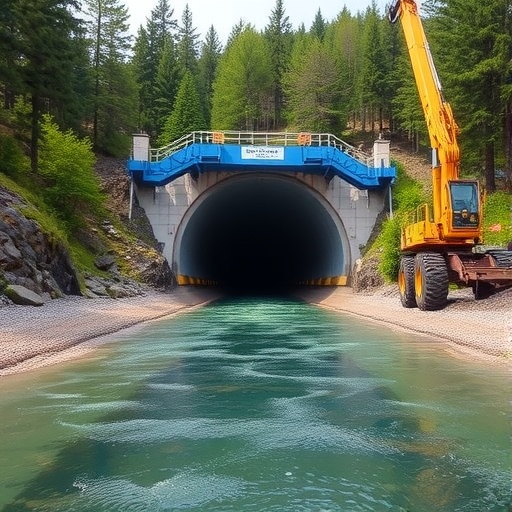In a groundbreaking advancement for civil engineering and environmental safety, researchers have unveiled a comprehensive numerical simulation addressing the seepage risk encountered during the construction of river-crossing tunnels. The intricate balance between human infrastructure development and the natural aquatic environment has always presented formidable challenges. However, the latest study published in Environmental Earth Sciences provides unprecedented insights into managing and mitigating water seepage, a perennial threat compromising tunnel integrity during its most vulnerable phase: construction below riverbeds.
Seepage, the uncontrolled infiltration of water through porous soil and rock surrounding a tunnel, presents an insidious challenge. While the engineering community has long known the hazards posed by water ingress, the dynamic interplay between groundwater flow, sediment composition, and excavation techniques remains complex. The study’s authors employed advanced numerical simulation techniques to unravel these multifaceted interactions, providing data-driven predictions for seepage potential under varying hydraulic and geotechnical conditions.
The research dives deeply into modeling water migration paths through heterogeneous geological layers. Utilizing a finite element method to simulate water pressure distribution and flow velocities, researchers reproduced realistic seepage scenarios encountered during excavation beneath river channels. By integrating fluid-solid interaction models, the study advances beyond conventional static analyses, bringing a more nuanced understanding of transient seepage phenomena that fluctuate as tunnel boring progresses.
A particularly illuminating aspect of the simulation lies in capturing the temporal evolution of seepage risk. Instead of viewing seepage as a static condition, the model accounts for how water pressure gradients and flow conduits evolve with excavation volume and sequence. This temporality offers engineers a predictive tool to identify critical phases at which protective measures such as impermeable linings or grouting become imperative, potentially averting structural failures or costly project delays.
The study also sheds light on the spatial variability of seepage risk along tunnel alignments beneath rivers. Natural sediment stratifications, fault zones, and variations in riverbed thickness all contribute to differing seepage vulnerabilities. By mapping these zones with high-resolution numerical data, construction planners can implement highly targeted reinforcement, optimizing resource allocation while enhancing the overall safety margins.
Moreover, the interdisciplinary approach of the research integrates hydrology, geotechnical engineering, and computational fluid dynamics. This synthesis allows for the coupling of surface water interactions with subsurface geophysical properties, enabling a comprehensive risk assessment framework. The result is a simulation capable of adapting to diverse riverine environments worldwide, from silt-heavy slow streams to turbulent mountain rivers with mixed sediment layers.
Going beyond traditional analytic approximations, the study’s authors harnessed state-of-the-art computing power to perform multiple scenario analyses, varying parameters such as groundwater head, tunnel depth, and soil permeability. Such sensitivity analyses are crucial for identifying the dominant factors influencing seepage and evaluating the robustness of proposed mitigation strategies under worst-case conditions. The findings emphasize the non-linear nature of seepage phenomena, where small changes in hydraulic conditions can precipitate disproportionately large risks.
Another pioneering contribution is the development of an integrated visualization toolkit embedded within the simulation framework. This tool converts raw numerical outputs into intuitive contour maps and flow vector diagrams, facilitating clearer communication between geotechnical engineers, hydrologists, and construction managers. Effective visualization ensures that complex seepage risks become accessible to all stakeholders, fostering collaborative decision-making to enhance safety procedures during the tunneling process.
The implications of this research extend into environmental preservation as well. By accurately predicting seepage patterns, the model helps prevent inadvertent contamination or destabilization of riverbeds and adjacent ecosystems. Effective management of seepage reduces sediment dislocation and water pollution risks that frequently accompany tunneling activities under sensitive aquatic habitats, thereby aligning infrastructure development with sustainable environmental stewardship.
In practical application, the insights derived from this simulation empower engineers to optimize tunnel lining designs. By quantifying seepage pressures and flow regimes, linings can be engineered with tailored permeability and strength characteristics. This precision not only enhances structural longevity but also leads to cost savings by avoiding excessive overdesign or inadequate protection that could lead to premature failures.
Furthermore, the study sets a new benchmark for regulatory compliance and safety standards in subaqueous tunneling projects globally. As infrastructure demands grow and river-crossing tunnels become more prevalent in urban expansion and transportation networks, the need for scientifically validated risk management tools gains prominence. This research fills a critical knowledge gap by linking theoretical modeling with practical construction realities.
The collaborative nature of the work is also noteworthy, combining expertise from hydrologists, civil engineers, and computational scientists. This multidisciplinary effort underscores the importance of integrated approaches in solving complex infrastructure challenges, laying a foundation for future innovations that merge environmental sciences with engineering disciplines to create resilient built environments.
In conclusion, the numerical simulation of river-crossing tunnel seepage risk unveiled by Pan, Wang, Cao, and colleagues represents a transformative leap in underground construction safety and environmental protection. With its rigorous technical foundation and holistic approach, the study equips engineers worldwide with the predictive insight necessary to overcome one of the most daunting obstacles in modern tunneling. As urbanization accelerates and demands for subterranean infrastructure intensify, tools such as this simulation will become indispensable in safeguarding both human endeavors and natural waterways.
Subject of Research: Numerical simulation of seepage risk during the construction of river-crossing tunnels.
Article Title: Numerical simulation of the river-crossing tunnel seepage risk during the construction process.
Article References:
Pan, Y., Wang, Z., Cao, C. et al. Numerical simulation of the river-crossing tunnel seepage risk during the construction process. Environ Earth Sci 84, 602 (2025). https://doi.org/10.1007/s12665-025-12550-4
Image Credits: AI Generated




